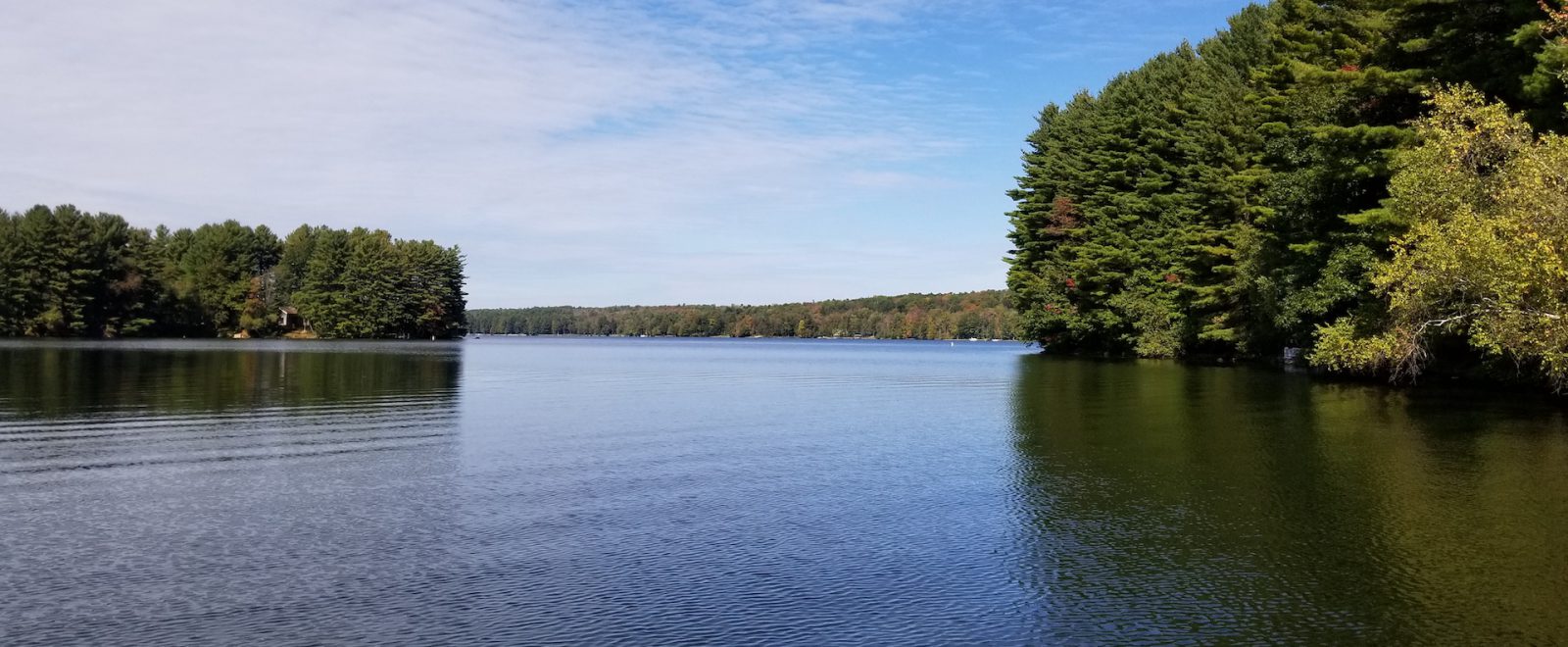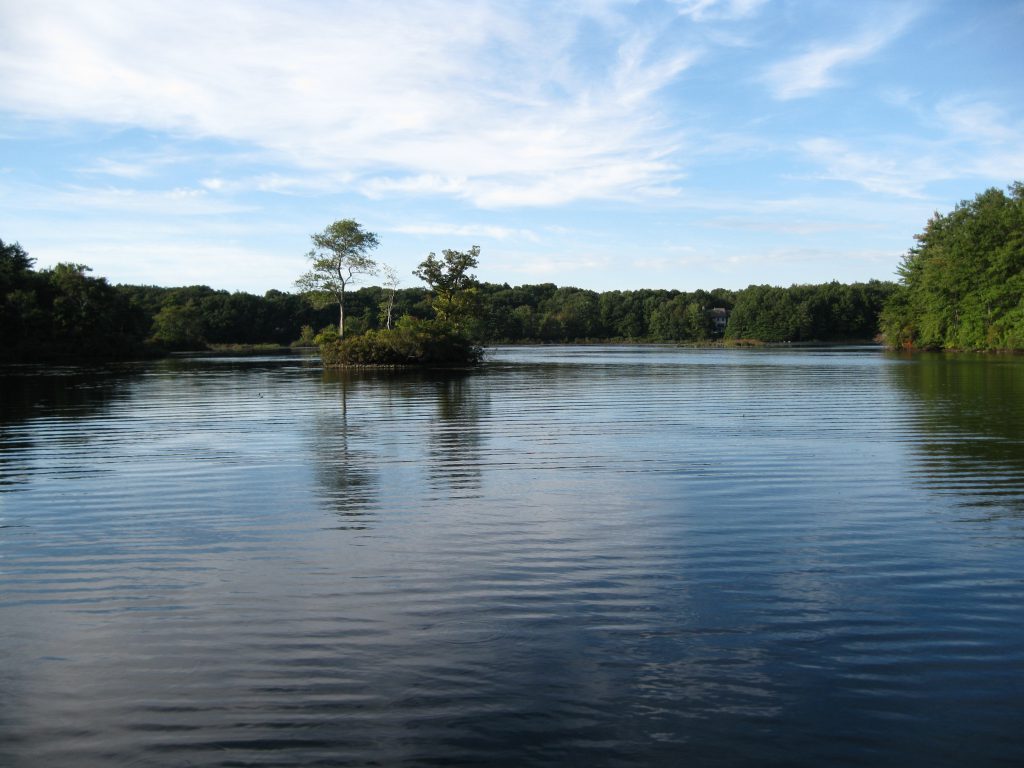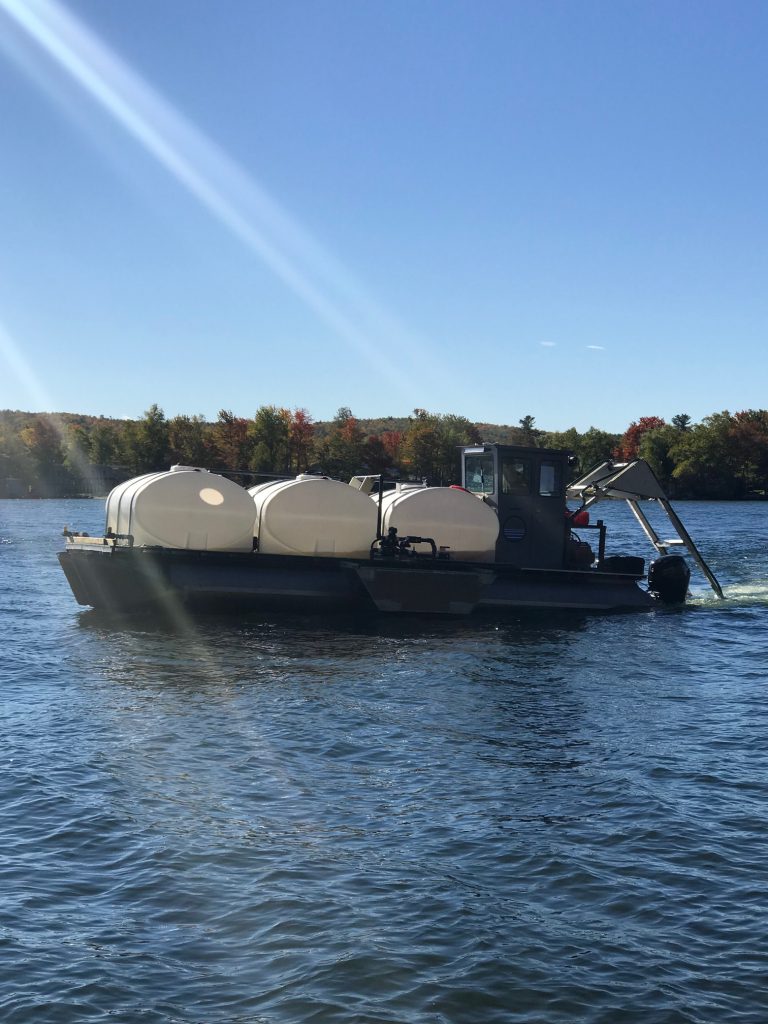

Site Description
Location: Auburn, ME
A large lake located in Auburn, ME, is used for recreational fishing and boating and is highly valued as the water supply source for several nearby cities. This lake covers an area of 2,261 acres, has a mean depth of 36 feet and a maximum depth of 118 feet. These features make the lake an ideal coldwater fishery and an excellent water source for a sizeable metropolitan area. This lake has a long history of use, both recreationally and as a public water supply. Development around the lake has decreased over the years and most of the shoreline remains undeveloped as the water district has purchased much of the surrounding land.
In recent years, the lake has been periodically plagued with algae and cyanobacteria blooms, posing a multitude of problems. These blooms are fueled by excess phosphorus from runoff and lake sediments, which is the limiting nutrient for cyanobacteria species. The coldwater fishery of this lake suffers greatly as these blooms can deplete oxygen rapidly at the lake bottom and cause fish kills. These fish kills are not only detrimental recreationally, but ecologically as large die offs can have drastic impacts on those organisms that survive.
Because this lake is also a potable drinking water supply, algae/cyanobacteria can have additional, very undesirable effects. Aside from deteriorating water quality, they can leave drinking water with a foul odor and taste. Furthermore, some species can potentially develop harmful toxins. This is arguably one of the greatest effects. Without close monitoring and management, these toxins can be detrimental to human health or require the implementation of more intensive water treatment methods, which can raise water rates to consumers.
Scope of Work
Aluminum sulfate application to help create water quality conditions that are undesirable for cyanobacteria.
Project Description
This reservoir is a drinking water supply so the Water District was faced with unique obstacles in maintaining control of nuisance algae/cyanobacteria. The lake covers a large area, which would make alternatives such as aeration nearly impossible due to the scale and price it would incur to execute. The traditional application of algaecides would also be ineffective as they do not provide long-term control, they would need to be applied on multiple occasions and they do not address the root cause of the problem. Alum, on the other hand, is regularly used in drinking water facilities. And similar alum treatments in other nearby lakes had already proven to be very successful in reducing nutrient levels and creating more balanced water quality conditions.
Alum treatment was chosen as a means of effective and proactive management at the lake by managing the problem at the source—inactivating phosphorus, much of which has infiltrated the waterbody in the runoff. This application utilized two liquid aluminum-based compounds, aluminum sulfate (alum) and sodium aluminate, which were applied to the lake. These components, when combined, form an environmentally-friendly floc that binds with suspended particles in the water—particularly phosphorus—while also maintaining a neutral pH. The resulting floc forms as crystals that settle to the lake bottom, essentially stripping the water of much of its phosphorus and also inactivating it in the sediment. This method starves algae/cyanobacteria of its nutrients and prevents the sediment phosphorus from being utilized should it be released and mixed through the water column during warmer months. Reduced algae productivity will also help to prevent oxygen depletion and protect the cold-water fishery.
Given the size of the lake and its use for drinking water, this was a unique project which was funded equally by the cities of Auburn and Lewiston. Areas of depth greater than 30 feet were chosen for treatment and delineated using GIS into seventeen 68-acre plots and one 12-acre plot. The treatment plots were then loaded to the onboard GPS unit before mobilization. Each of these areas received aluminum sulfate and sodium aluminate, apart from the 12-acre plot that received a lower quantity.
Monitoring of the application was performed throughout the treatment by scientists with the Lake Stewards of Maine as well as by the cities’ Water District staff. Various factors were considered including pH, aluminum levels, and alkalinity, among other parameters. SOLitude’s team of experts met daily with the monitoring scientists, plant staff, city representatives, and the watershed manager. During these meetings, current water parameters were reviewed, updates were given regarding the application of the previous day, and any concerns were addressed regarding weather conditions to ensure safe, effective treatment.
Two application barges were utilized for this project, the first was mobilized to the site in July 2019. This barge utilized onboard containment for products, onboard pump systems, twin outboard engines, GPS guidance and a powered submersible boom. Using onboard electronics controlled by the applicators, the products were pumped to the boom and applied subsurface. The water facility was utilized for chemical storage tanks and as a docking station for the barge to load supplies.
A redesigned application barge was mobilized to the lake in late July. The updated barge features greater storage capacity, the most technologically advanced pump system and electronic controls, as well as more powerful engines. The features of this barge allowed for a major increase in treatment efficiency compared to the original.

Given the EPA standards for drinking water, the project took a precautionary hiatus to allow residual aluminum levels to decrease to more desirable levels. Application at the lake resumed once desirable aluminum levels had been achieved in October. The treatment was successfully completed with the desired dose of aluminum distributed over 1,168 acres in late October 2019. No adverse effects on wildlife or water quality occurred.
This project posed a unique set of circumstances regarding the size of the waterbody, weather, and magnitude of the treatment. The expertise and cooperation of all the partners involved, along with the implementation of our new alum barge, was instrumental in the success of the project. This project was among the largest alum projects SOLitude has undertaken and was completed in an effective and timely manner given the project constraints.
Overall, the SOLitude team applied the product over approximately six weeks of treatment. Monitoring continues at the lake by the local Water District, and many years of reduced phosphorus and, thus, nuisance algae/cyanobacteria are to be expected as a result of this project.









